-
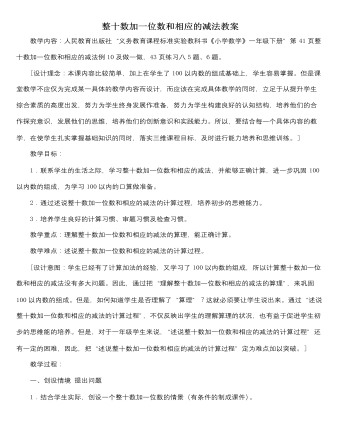
人教版新课标小学数学一年级下册整十数加一位数和相应的减法教案
[设计意图:巩固减法的意义,培养学生初步的思维能力。](2)组织学生自己先算一算,教师巡视,捕捉学生学习信息,纠正不良学习习惯。[设计意图:通过巡视,及时捕捉学生的学习信息,发现问题及时解决;把培养学生良好的计算习惯、审题习惯及检查习惯落到实处。](3)组织学生全班交流计算方法。组织学生在全班交流解决计算“32-2=”的方法,引导学生理解“32是由3个十和2个一组成,从32里去掉2,就剩3个十,所以32减2等于30”。如果学生用其他的方法来计算,只要正确,也要肯定。[设计意图:同前面一样,巩固数的组成,训练每一个学生“述说整十数加一位数相应减法的计算过程”,突破难点。]3.加减法对比组织学生比较“30+2=32”和“32-2=30”,并说一说有什么发现,使学生认识到“3个十和2个一组成32,所以30加2等于32;反过来,32是由3个十和2个一组成,从32里去掉2,就剩3个十,所以32减2等于30”[设计意图:强化加减法意义的联系,培养学生初步的思维能力。]
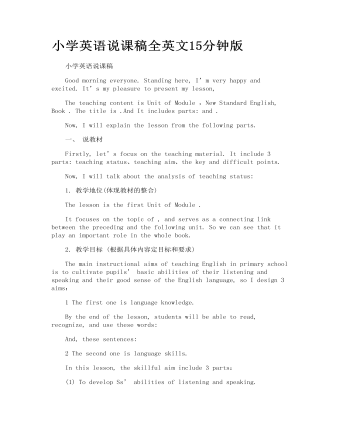
小学英语说课稿全英文15分钟版
一、 说教材 Firstly, let’s focus on theteaching material. It include 3 parts: teaching status、teachingaim、the key and difficult points. Now, I will talk about the analysis of teaching status: 1. 教学地位(体现教材的整合) The lesson is the first Unit of Module . It focuses on the topic of , and serves as a connectinglink between the preceding and the following unit. So we can see that it playan important role in the whole book. 2. 教学目标 (根据具体内容定目标和要求) The main instructional aims of teaching English inprimary school is to cultivate pupils’ basic abilitiesof their listening and speaking and their good sense of the English language,so I design 3 aims:

人教版新目标初中英语七年级下册It’s raining教案2篇
1 Each group choose one place to describe and what you are doing in it Choose one place, and describe what they are doing 2 Move around the room and give suggestions Talk about it and write it down 3 Ask one to show their works and act it Choose one of each group to make a report 4 Evaluate the best group and the best reporter Choose the best one Homework Ask your friends their ideal place and write about it教学反思:新课程标准中强调学生在课堂中的主体地位,在综合课中他们的主体地位就更加突出。在各个活动中给不同程度的学生不同层次的任务,让各层面的学生都有表现发挥的机会,从而产生对英语的兴趣。使用照片图片多媒体来辅助教学,效果更好。同时让了解其他国家风景,风俗的同学介绍ideal place,增加学生的背景知知识,实现跨学科交流的目的。教案点评:采用任务型教学模式,在各个活动中给不同程度的学生不同层次的任务,让各层面的学生都有表现发挥的机会,从而产生对英语的兴趣。使用照片图片多媒体来辅助教学,效果更好。让了解其他国家风景,风俗的同学介绍ideal place,增加学生的背景知识,实现跨学科交流的目的。

人教版新目标初中英语八年级下册It’s a nice day, isn’t it教案2篇
"Hello! Welcome to English class! Introduce yourself. Meet your new classmates." That's what the teacher says. What do you say? "Oh no!" It can be difficult talking to new people. But it can be fun, and you can make friends. How do you do it? Make small talk. Small talk is polite conversation. "Wang Nan is a great pingpang player, isn't she?" "I'd love to meet her, wouldn't you?" "It's been raining a lot, hasn't it?" Tag questions are a form of polite speech. To make small talk successfully, you should know how to make them. You should also know what topics to talk about. Try to learn this unit carefully. The next time you're in English class, you'll find out. Making small talk's easy, isn't it? (“你好!欢迎你!请做一下自我介绍。认识一下你的新同学。”通常在课上老师会这样说。你会说什么呢?“噢,不!”与陌生人谈话太困难了。但是这也很有意思,并且你还能交到朋友。你该怎么做呢?闲聊。闲聊指得是礼貌的对话。“王楠是一个很棒的乒乓球运动员,不是吗?”“我希望自己能认识她,你呢?“今年的雨水很多,不是吗?”反意疑问句是一种礼貌用语。为了使得谈话成功,你应该知道怎样去进行闲聊。你还应该知道与不同的人该谈论什么样的话题。认真的学习这个单元吧,下次在英语课上,你会发现与大家展开谈话是一件很容易的事情,不信我们来试试。)

人教版新目标初中英语七年级下册Where is the post office教案2篇
Period 2 (3a----Section B 2c)Preview(Pre-task): Key points: What laAdd another information about their pen pals----their language on the cardnguage does she/he speak?She/He speaks....Does she/he have any brothers and sisters? Does she/he speak English?Preview(Pre-task): Add another information about their pen pals----their language on the cardKey points: What language does she/he speak?She/He speaks....Does she/he have any brothers and sisters? Does she/he speak English?Step 1 Revision1.Revisionand dictation of the new words 2.Revise the drills they learned yesterday.(by pairwork and grammar exercise)Step 2 Leading-inT has a conversation with one student. The conversation is following:---Do you have a pen pal?---Yes, I do.---What's your pen pal's name? ---His/Her name is....---Where is your pen pal from? ---He/She is from...---Where does he/she live? ---He/She lives in....---What language does he/she speak?He/She speaks...Write the new words on the Bb. They are following: EnglishChineseJapaneseFrenchStep 3 LearnLearn the new words with the whole class.Finish 3a with the students3b Pairwork T still does an example with one student Then the Ss practise in pairs. The example is following:--Curry Muray is my pen pal. He is from the United States.---What language does he speak?

人教版新目标初中英语八年级下册Would you mind turning down the music教案
Step 4. Group work (4)1. Ask a pair of students to read the dialogue. Say, This activity provides speaking, listening and writing practice using the target language.2. Ask students to complete the work in groups.3. Check the answers with the whole class. 4. Explain some of the language points. Step 5. Word review (Self check 1)1. Ask students to read the words and the phrases given. 2. Fill in the blanks with proper forms of these words to complete the sentences. 3. Check the answers with the whole class. Homework:Do activity 2 on page 57 after class. Period 6Teaching aims: 1. Teach vocabulary words and the useful expressions. 2. Enable the students to learn etiquette in different culture. 3. Help the students learn how to behave politely in public places and in daily life. Teaching procedures:Step 1. RevisionHelp students to review the function of making requests through a free talk. Then lead them to the topic of etiquette. Explain the meaning of etiquette. Or, ask students to look it up in the dictionary. Step 2. Pre-reading (Section 1)1. Ask students to read the picture and make a list with their partner about how many rules of etiquette can be seen being broken.

人教版新目标初中英语八年级下册If you go to the party, you’ll have a great time教案2篇
区分宾语从句、定于从句和状语从句宾语从句和状语从句,都叫做主从复合句。宾语从句主要是中考必考的,是初中阶段必掌握的从句,宾语从句主要是掌握三要素,所谓宾语从句,就是宾语在主从复合句当中充当宾语的一个句子,叫做宾语从句。主句的谓语动词是及物动词,后面如果是词或者是短语的话,是简单句,如果是句子的话,肯定是宾语从句。I know that he good at English.就是宾语从句,三要素,一要素是要注意连词,连词一共学了三类连词,一类连词是that口语当中可以省略,就像刚才说的那一句,I hear he is good at English.还有疑问代词、疑问副词,how where when,疑问代词、疑问副词。还有一类连词weather是否的意思,不是状语从句当中的如果,这一定要和如果区分开,这是是否。I don't know if he interested at English。宾语从句要注意if是连词。第二要素是语序,要用陈述举语序。比如说你家有几口人,我们都说How many people are there in you family?但是这是简单句,一旦说成宾语从句,你可以告诉我你家有几口人吗?Could you tell me how many people there are in you family ?

人教版新目标初中英语九年级下册Could you please tell me where the restrooms are教案
Step Ⅰ RevisionCheck homework. Ask a few students to read the article in 3a.Then ask a few students to read their guides.Step Ⅱ Part 1Look at the words in the box. Ask a student to read them. Make sure the students understand the meaning of the words. You are to fill in the blanks with the words. In some cases, students may need to use another form of the word, for example adjusting for tense or subject/ verb agreement.Ask students to fill in the blanks on their own.Check the answers. Step ⅢPart 2Go through the instructions with the class.Look at the example with the students.Ask students what the answer would be.Ask a student to read the question and answer it.Excuse me, could you tell me where the bank is, please?The bank is across the street from the shopping malt.Get students to complete the work in pairs.Check the answers. Ask a few students to read their questions.Step Ⅳ Just for Fun!Ask all the students to read the conversation. Ask: What is funny about this cartoon? Help students to explain. A Martian is a person from the planet Mars.There is no such thing as Martian food on Earth, and the clerk looks silly because he is trying to think of where there is a Martian restaurant.Invite some pairs of students to present this conversation to the rest of the class.Step Ⅴ Summary and HomeworkIn this class, we’ve done much writing practice using the key vocabulary words and the target language presented in this unit. After class, please finish the questions in 2 in your exercise books. Then finish the exercises on pages 47~48 of the workbook as well.The Seventh Period Ⅰ Teaching Aims and Demands1. Knowledge Objects(1) Key Vocabularyimage, adventure, jealousy, hero, crime, journey, brave, no longer, show interest in, take it easy, become interested in, plain looks(2)Text:Grown-ups like cartoons, too.2. Ability Objects(1) Fast-reading to get a general idea of the text.(2) Careful-reading to get the detailed information in the text.

人教版新目标初中英语九年级下册I’ll help clean up the city parks教案
Talk about offering help (P60)I’ll help clean up the city parks.A: I’d like to work ...B: You could help ...Talk about ways to tell people about the Clean-Up Day (P61)We need to ...We can’t ...I’ll ...Talk about the work the volunteers do (P62)These three students all volunteer their time to help other people.Somebody loves to ... / helps ... / plans to ... / wants to ...A: What do you like doing?B: I like ... A: What kind of volunteer work do you think I could do?B: You could ...1. 重点词汇advertisement, fix, repair, pleasure, blind, deaf, shut, carry, specially, fetch2. 认读词汇hunger, homeless, cheer, clean-up, sign, establish, major, commitment, elementary, veterinarian, coach, similar, call-in, strategy, disabled, organization, unable, support, appreciate, donation, part of speech, pronoun, adverb, preposition, conjunction, donate, Jimmy, Sally3. 词组clean up, cheer up, give out, put off, set up, think up, take after, fix up, give away, put up, hand out, work out, at once

人教版新目标初中英语九年级下册We’re trying to save the manatees教案2篇
本单元主要围绕着有关濒临灭绝的动物这一话题,学习了应该怎样保护我们的环境,以及就某一问题展开辩论。目标提示语言目标能够运用所学知识,就某一问题展开辩论。认知目标1、复习一些语法:现在进行时、一般现在时、用used to 表示一般过去时、现在完成时、一般过去时的被动语态。2、学会表达同意和不同意。3、学会以下基本句型:We’re trying to save the manatees.Manatees eat about 100 pounds of food a day.There used to be a lot of manatees.In 1972,it was discovered that they were endangered.Some of the swamps have become polluted.情感目标了解一些濒临灭绝的动物的生活习性和濒临灭绝的原因,教育学生应该如何保护环境。教学提示充分利用多媒体等教学设备,创设与本课话题相关的情境,如各种不同种类的动物、动物园以及有关环境的画画等等。围绕着本单元的教学目标,设计一些贴近学生实际的教学任务,如让学生谈论自己最喜欢的动物,如何拯救濒危动物,如何保护环境等等。让学生根据所学知识,就动物园是否对动物有利以及其他的话题进行辩论。
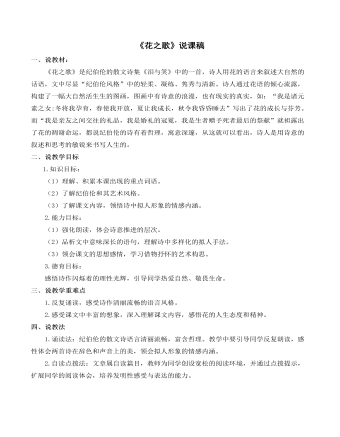
部编人教版六年级上册《花之歌》说课稿
一、说教材: 《花之歌》是纪伯伦的散文诗集《泪与笑》中的一首,诗人用花的语言来叙述大自然的话语,文中尽显“纪伯伦风格”中的轻柔、凝练、隽秀与清新。诗人通过花语的倾心流露,构建了一幅大自然活生生的图画,图画中有诗意的浪漫,也有现实的真实,如:“我是诸元素之女:冬将我孕育,春使我开放,夏让我成长,秋令我昏昏睡去”写出了花的成长与芬芳。而“我是亲友之间交往的礼品,我是婚礼的冠冕,我是生者赠予死者最后的祭献”就袒露出了花的凋谢命运,都说纪伯伦的诗有着哲理,寓意深邃,从这就可以看出,诗人是用诗意的叙述和思考的敏锐来书写人生的。 二、说教学目标 1.知识目标: (1)理解、积累本课出现的重点词语。 (2)了解纪伯伦和其艺术风格。 (3)了解课文内容,领悟诗中拟人形象的情感内涵。
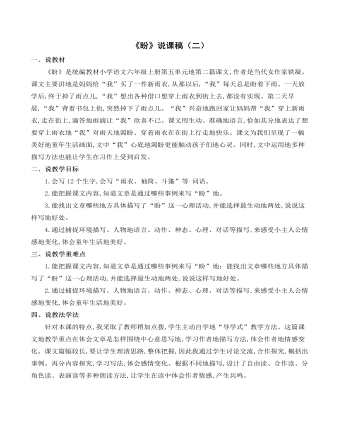
部编人教版六年级上册《盼》说课稿(二)
一、说教材 《盼》是统编教材小学语文六年级上册第五单元地第二篇课文,作者是当代女作家铁凝。课文主要讲地是妈妈给“我”买了一件新雨衣,从那以后,“我”每天总是盼着下雨。一天放学后,终于掉了雨点儿,“我”想出各种借口想穿上雨衣到街上去,都没有实现。第二天早晨,“我”背着书包上街,突然掉下了雨点儿。“我”兴奋地跑回家让妈妈帮“我”穿上新雨衣,走在街上,滴答地雨滴让“我”欣喜不已。课文用生动、准确地语言,恰如其分地表达了想要穿上雨衣地“我”对雨天地渴盼、穿着雨衣在在街上行走地快乐。课文为我们呈现了一幅美好地童年生活画面,文中“我”心底地渴盼更能触动孩子们地心灵。同时,文中运用地多种描写方法也能让学生在习作上受到启发。 二、说教学目标 1.会写12个生字,会写“雨衣、袖筒、斗篷”等 词语。 2.能把握课文内容,知道文章是通过哪些事例来写“盼”地。

部编人教版六年级上册《盼》说课稿(一)
【教材分析】《盼》是六年级第五单元的一篇课文。本文选自作家铁凝的第一本出版小说《夜路》,是一篇儿童文学类的小说。作者以孩子的视角,记述了得到新雨衣,渴望下雨到愿望实现——在雨中穿上了新雨衣的故事。用细腻的语言描述了小主人公情感和心理的变化,表现了童真童趣。【教学目标】1.疏通重难点字词的读音和写法。2.整体感知课文内容,把握故事情节,理清行文思路,感受小主人公因新雨衣而产生的“盼”。3.通过捕捉环境描写、人物的语言、动作、神态、对话等描写,来感受小主人公情感的变化。【教学重难点】通过捕捉环境描写、人物的语言、动作、神态、对话等描写,来感受小主人公情感的变化。【教学过程】核心问题:作者如何围绕一个“盼”字展开描写,表现小主人公的情感变化?

人教版新目标初中英语七年级下册What does he look like教案3篇
所需要用到的句子:Who is that?That is Jack. I like him.Why do you like him?I like him because he is interesting.Task 4: 设计理想中的人类Step one: 设计理想中的人类的外貌。把全班同学分成若干小组,学生可以边说边在纸上画出他们的模样。Step two: 设计理想中人类的性格。学生们可以把那些能描述性格的单词写在图画的旁边。Step three: 每组选出一名同学,其他同组同学提问,他作简单回答,并说明原因。所需用到的句子:What does he or she look like?He or she ...What is he or she like?He or she is ...Why?Because ...Task 5: 挑战性活动调查性格是天生的还是后天形成的,让每个同学回家去调查一下自己成长过程中性格是否有变化,具体是怎样的,为什么会这样? Teaching Aims:1. Enable students to have a general understanding of how to talk about people's physical appearance.2. Enable students to tackle some essential vocabularies and patterns about describing people. Provide them with necessary skills and methods.3. Create various chances for students to describe the persons they're familiar with, such as classmates, family members, teachers, idols, etc.

人教版新目标初中英语七年级下册What do you think of game shows教案
五、教学Section B-2c1. Pair work: What do you think of the belt/sunglasses/…? What does your father/mother/… think of your scarf/belt…?2. Group work(1). Teacher shows some different kinds of school uniforms (制服)and asks : “ What do you think of your school uniforms? If you have a chance to choose your school uniforms, what kind would you like to choose?”(2). Discuss in groups.(3).Get some Ss to report in class.说明:这一步旨在让学生运用已有的语言知识谈论对事物的看法和意见,并简单阐明理由,培养学生的主动思维能力和运用英语的能力。六、教学拓展调查电视节目的收视率任务:调查你周围的人对现在各种电视节目的反响。活动过程:1.教师布置任务,让学生调查周围的人(包括他的亲戚朋友和邻居)喜欢收看哪方面的电视节目。2.学生进行调查活动,运用本单元所学的句型What do you think of….? (Why?)What's your favorite game shows?What do you think of talk show?I doesn’t mind it.I like it.I love it.I can’t stand it.3.记录下排在前10位的TV Program,填写调查表,比较其收视率。

人教版新目标初中英语八年级下册What should I do教案2篇
说明:在帮Li Lei提建议的同时,教育学生如何学好英语。第三课时教学目标1. 语言目标:a) 词汇: Original, in style, haircut, the same as.b) 语言结构:My friend wears the same clothes and has the same haircut as I do.2. 能力目标:大多数学生能够谈论自己喜欢哪种服装,提高查找信息的能力。3. 情感目标:学会如何与朋友相处,要有自己对时尚的看法。教学重点掌握一些重要词汇。教学难点学会谈论问题,并能提出书面建议。◆教学突破首先针对Erin的问题,提出个人的建议,模仿2c部分的对话展开双人交际Pair-work;听老师诵读3a部分的信件,并找出LEFT OUT的问题所在;学生完成3b部分的内容,给Left Out提出书面的建议;学以口头形式提出自己目前存在的某个问题,讲给大家听,让同学们给自己提出一个建议,并作笔录;学生两、三个人分成一组,随意性地进行口语交际,谈论P14的第4部分的某个问题,相互交换意见。
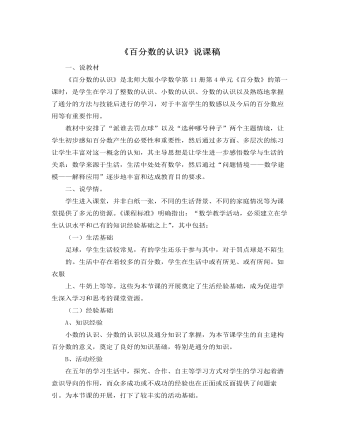
北师大版小学数学六年级上册《百分数的认识》说课稿
3、概括百分数的意义师:通过刚才同学们的互相合作交流你感受到,百分数表示什么意思吗?请你先自己想一想,然后同桌合作交流一下。(在充分的表述对百分数的意义认识基础上,由生活信息概括提炼出的百分数的含义)4、教学百分数的读写法百分数的读对于学生来说比较简单,重点介绍%的写法。教师出示带有情境的一组百分数数据信息,先让学生自读,再提问:读了这些数据发现了什么?使学生了解到百分号前面的数可以是整数、小数,可以比100大可以比100小,完善对百分数的认识,同时也渗透德育教育,让学生通过数据说说自己的体会,得到热爱祖国、热爱家乡、爱护环境的教育。5、百分数与分数的联系区别这是教学中的难点,纯语言的表达过于抽象,也不利于理解。因此它们之间的区别与联系是通过练习的形式解决。
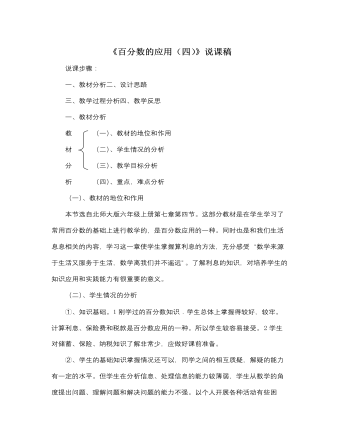
北师大版小学数学六年级上册《百分数的应用(四)》说课稿
1.注重创设情境,让学生从现实生活中学习数学。“良好的开端是成功的一半。”精彩的开篇不仅很快集中了学生的注意力,而且调动了学生主动参与学习的积极性。所以课的开始,我设计了王叔叔的例子.我的话语一落下,同学们就纷纷举起了手,发表自己的看法。首选的办法就是存银行,并且说出储存银行的好处。一是可以获得利息增值;二是可以支援国家建设。学生了解了储蓄的意义,从而引出课题,使他们感到要学习的内容与现实生活的紧密联系,有利于提高学习的兴趣.2、给学生充足的探索空间,让学生成为学习的主人。课堂上,让学生主动地进行数学学习,动手实践、自主探索、合作交流。3、积极引导学生把知识应用到生活中。数学来源于生活,也服务于生活,引导学生学会把课本中的所学,应用到日常生活中,学生对存款中的有关计算利息,本金、利率等知识了解的同时,也能结合学习中的体验开展实践交流活动,形成良好的消费观,也能把储蓄、纳税的知识应用到现实生活中来。
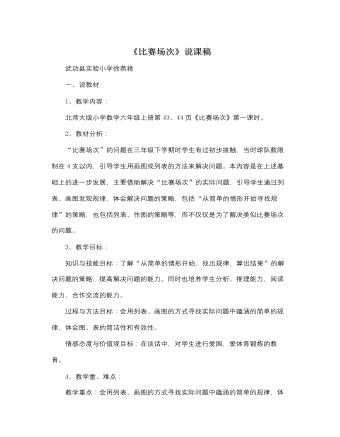
北师大版小学数学六年级上册《比赛场次》说课稿
引导学生发现:把8名同学的复杂问题,转化为从2名开始研究,到3名,到4名,到5名,找出规律。相机补充图表中没有填上的算式是:1+2+3+4=10重点分析:为什么+2、+3、+4呢?让学生充分地看图理解,并充分让学生说出从表或图中所发现的规律。引导学生发现:每增加一名队员,该队员都要分别跟之前的队员进行一场比赛,所以增加的场数应该是(人数-1)还要说明-1是因为自己不和自己比。出示课件,让学生说算式,然后概括所有的情况,n个人比赛,规律是:引导学生发现解决策略:从简单的情形开始,找出规律,算出结果。(板书)利用规律学生独立解决问题。(设计意图:给予学生充分探索规律的时间和空间,让学生动脑思考,动手写出规律,在自主探究中理解“从简单的情形开始,找出规律,算出结果。”的策略,培养学生合作和发现问题的能力。)生活中还有什么问题和这个问题的道理是一样的?全班交流:握手、拥抱??
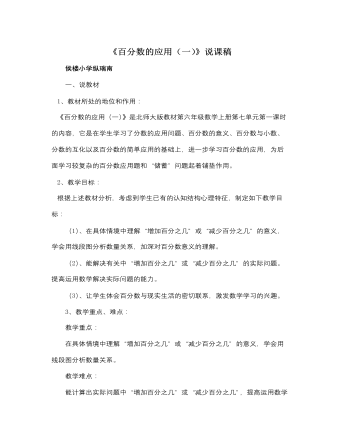
北师大版小学数学六年级上册《百分数的应用(一)》说课稿
在交流的过程中,教师要站在“导”的位置上,放手让学生说,最后总结出,解决这个问题,重点要理解问题的实质含义:究竟是谁和谁比,谁是单位“1”。本环节的设计既拓宽了解题思路,又锻炼了表达能力,同时也提高了抽象概括能力。(五)巩固拓展:实战演练,我最棒!在练习的设计上,我兼顾了习题的层次性和开放性,使不同层次的学生都参与练习,以求训练思维、培养能力、形成技能。(六)课堂总结通过学生说一说本节课自己的收获,达到对本节课知识点的梳理与整理,进一步巩固对知识点的掌握。总之,本节课教学活动我力求充分体现以下特点:以学生为主体,充分关注学生的自主探究与合作交流。教师是学生学习的组织者、引导者、合作者,对一个问题的解决不是要教师将现成的方法传授给学生,而是引导学生寻找解决问题的策略,给学生一把在知识的海洋中行舟的桨,让学生在积极思考,大胆尝试,主动探索中,获取成功并体验成功的喜悦。